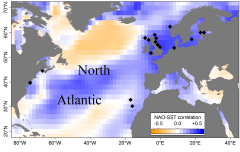Citation: Sandvik, H., T. Coulson, and B.-E. Sæther (2008) A latitudinal gradient in climate effects on seabird demography: results from interspecific analyses. Global Change Biology, 14, 703–713.
doi: 10.1111/j.1365-2486.2007.01533.x [what’s a doi?].
Key words: Breeding success, demography, interspecific analysis, latitude, North Atlantic Oscillation, sea surface temperature.
 Abstract: For an understanding of the effect of climate change on
animal population dynamics, it is crucial to be able to identify which climatologic
parameters affect which demographic rate, and what the underlying mechanistic links
are. An important reason for why the interaction between demography and climate
still are poorly understood is that the effects of climate vary both geographically
and taxonomically. Here we analyse interspecifically how different climate
variables affect the breeding success of North Atlantic seabird species along
latitudinal and longitudinal gradients. By approaching the problem comparatively,
we are able to generalise across populations and species. We find a strong
interactive effect of climate and latitude on breeding success. Of the climatic
variables considered, local sea surface temperatures during the breeding season
tend to be more relevant than the North Atlantic Oscillation (NAO). However, the
effect of NAO on breeding success shows a clear geographic pattern, changing in
sign from positive in the south to negative in the north. If this interaction is
taken account of, the model explains more variation than any model with sea surface
temperature. This superiority of the NAO index is due to its ability to capture
effects of more than one season in a single parameter. Mechanistically, however,
several lines of evidence suggest that sea surface temperature is the biologically
most relevant explanatory variable.
Abstract: For an understanding of the effect of climate change on
animal population dynamics, it is crucial to be able to identify which climatologic
parameters affect which demographic rate, and what the underlying mechanistic links
are. An important reason for why the interaction between demography and climate
still are poorly understood is that the effects of climate vary both geographically
and taxonomically. Here we analyse interspecifically how different climate
variables affect the breeding success of North Atlantic seabird species along
latitudinal and longitudinal gradients. By approaching the problem comparatively,
we are able to generalise across populations and species. We find a strong
interactive effect of climate and latitude on breeding success. Of the climatic
variables considered, local sea surface temperatures during the breeding season
tend to be more relevant than the North Atlantic Oscillation (NAO). However, the
effect of NAO on breeding success shows a clear geographic pattern, changing in
sign from positive in the south to negative in the north. If this interaction is
taken account of, the model explains more variation than any model with sea surface
temperature. This superiority of the NAO index is due to its ability to capture
effects of more than one season in a single parameter. Mechanistically, however,
several lines of evidence suggest that sea surface temperature is the biologically
most relevant explanatory variable.
Full text: © 2008 The authors. If you accept (i) the conditions specified in the Creative Commons "Attribution-NonCommercial-NonDerivs" 2.5 licence, and (ii) that printouts have to be made on recycled paper, you may download the article here (pdf, 0.3 MB).